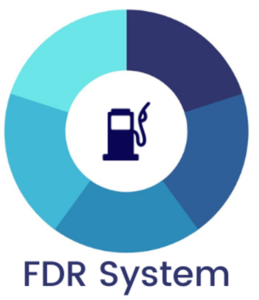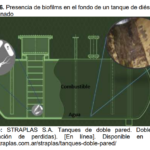Currently there are a wide variety of qualitative methods that allow the detection of microorganisms specifically in fuels in a quick and simple way, since they do not require much sample preparation; it should be noted that when assessing microbiological contamination in the fuel it is necessary to take into account the aqueous phase present at the bottom, as this is where the greatest microbial load is going to be found.[1]. Generally, one of the best treatments for the control and mitigation of microorganisms in fuels is good housekeeping practices, such as in-tank cleaning and periodic water drains. However, this type of cleaning is difficult to perform on a regular basis, as it involves high costs, in addition to lost sales per cleaning days per year.
It should be noted that this type of maintenance is considered high risk due to tank degassing, disconnection of electrical and pneumatic systems, among others. For this reason, this type of maintenance should be performed as a complement to a microbiological control. Among the methods used by the ESD to combat background problems and microbiological contamination we can find the following:
Microfiltration equipment. These are systems that are installed before the pump, in order to filter the fuel that leaves the storage tank and is delivered to the consumer's vehicle. They have filters of between 3 and 5 microns, which ensures a high retention of contaminating particles.
Tank cleaning. Also called dialysis, it consists of the recirculation of the fuel located at the bottom of the tank, using a probe. This probe extracts the fuel from the bottom, passes it through a series of filters, which retain the different contaminants. Finally, the clean fuel is returned to the storage tank.
These methods do not ensure the removal of bio-films adhering to the walls of the storage tank or the reduction of microbiological load in the fuel. They are generally used to improve the appearance of the fuel at the bottom of the tank or to remove possible water deposits.
In our case, we incorporate elements that disinfect the fuel and when it is returned to the tank it is done in such a way that it drags all the impurities and microorganisms, so that in the time that lasts the process of action of the machine all have been filtered and pass through the disinfection chamber of our machine.
The quality of the disinfection process must be emphasized, in which no additives or biocides have to be added to the fuel and the quality of the fuel is not degraded in the process.
Biocidal products are "substances capable of eliminating or controlling the proliferation of microorganisms capable of causing alterations in humans, animals and the environment. The different chemical families of biocidal compounds have different profiles of action, but they all share the characteristic of being lethal to microorganisms under a certain set of circumstances that make them viable for marketing", but has the following problems:
- They do not have the same ability to mitigate the concentration of microorganisms in both the aqueous phase and the fuel.
- They usually have a limited spectrum of microbial activity.
- It has an inhibitory effect in the presence of other substances.
- Often corrosive in fuel systems.
- Degrades fuel properties.
- They are generally not safe for both human use and the environment.
- High cost. Approximate price of about 50 € per 1,000 liters of fuel.
- It forces you to use it indefinitely once the problem has appeared.
But the main problem is that they do not solve the problem definitively because if a small amount of microbial residue remains, it will reproduce over the months. That is why it is essential to maintain it indefinitely in case of a first detection of microbes.
Disinfection by dosing with a biocidal agent presents the following difficulties:
- It is not possible to use them in all tanks, due to their morphology and location.
- The cost depends very much on the difficulty of access to the tank. For example, it is 30,000 € on average for a boat with a tank of 10,000 liters of fuel (The cost: 15,000 € for removal of contaminated fuel and transfer to a recycling station, 5,000 € for cleaning the tank and filters, and 10,000 € for refueling).
The standard boat of the study is a boat with a tank of 10,000 liters of fuel, which corresponds to an average boat within the recreational boating. For this boat is the one for which we have calculated the retail price of a machine at 5,000 €.
1] GAYLARDE Christine, BENTO Fatima, KELLEY Joan. Microbial contamination of stored hydrocarbon fuels and its control. In: Journal of Microbiology. February 1999. Vol 30, no 1, p. 01- 10. ISSN 0001-3714




Leave a Reply
Want to join the discussion?Feel free to contribute!